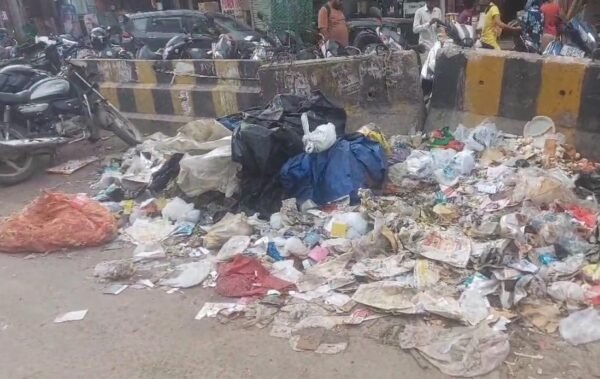
This image captures the state of Bada Bazar, Gurugram post 2 PM.
Bilkul Sateek News
Gurugram (Paridhi Dhasmana), 17 July – If irony had a permanent address, it would surely read: Gurugram, Haryana.
In a spectacular twist of perception versus reality, Gurugram has secured the 41st spot in the Swachh Survekshan 2025 rankings—leaping 99 spots from its 2024 standing. On paper, that’s an applause-worthy feat. But on ground? Residents are dodging open garbage piles, navigating choked drains, and wading through sewage-swamped lanes. The city may be shining in the spreadsheets of the Ministry of Housing and Urban Affairs, but on the streets, it’s a different picture—a murky, unpleasant one.
To put this in perspective: Gurugram ranked 140th last year. Now, somehow, amid unattended waste, overflowing bins, and non-existent civic response in several sectors, it’s jumped into the top 50. The mind boggles, the nose wrinkles, and the taxpayer asks—How?
Meanwhile, Indore has once again bagged the crown as the cleanest city in India, maintaining its unshakable hold on the top rank. Surat and Navi Mumbai follow close behind, offering not just swanky roads but also genuine civic discipline and responsive governance. Gurugram, in contrast, feels more like the overconfident student who somehow passed the exam despite bunking every class.
Sector 7’s waterlogged streets, Sector 37’s open dumping grounds, and the forgotten colonies of Bhim Nagar and Basai are just a few exhibits in this civic circus. Despite multiple complaints from residents, the response from authorities has ranged from delayed to dead silence. The sanitation staff, overstretched and visibly absent in several areas, appears to be as clueless as the public about the city’s sudden ranking resurrection.
Even more perplexing is the absence of any major transformation projects in the last one year that could justify such a leap. No visible smart bins, no remarkable improvement in public toilets, no dramatic changes in solid waste management. What’s improved, perhaps, is the paperwork. Or maybe Gurugram has become a masterclass in perception management.
The city’s residents, though, aren’t buying the clean chit. On the ground, frustration has fermented into fatigue. Senior citizens like BN Chopra and his wife, residents of an area chronically ignored by civic authorities, ask a painfully valid question — “Is it too much to expect timely action in return for the taxes we pay year after year?”
And theirs is not an isolated voice. In a separate report on the stray animal menace—and in several other ground reports across Gurugram—the statements echo with eerie sameness. “Nothing is going to change. Everyone has accepted it,” said Parth, a local resident, capturing the resignation that now defines public sentiment.
What was once outrage has now curdled into quiet despair. Hope, like the garbage, seems to have been left to rot.
Sanitation Crisis in Sector 41: Garbage Piles Up, Authorities Say ‘No Resources’
It’s not just about aesthetics; this is a health issue. With monsoon in full swing, the risk of disease outbreaks looms large. The lack of proactive fumigation, drainage maintenance, and daily cleaning in many wards has made Gurugram an urban petri dish. And yet, in this year’s national cleanliness anthem, Gurugram seems to be humming a victory tune.
There’s no denying that data collection for Swachh Survekshan is massive and multifaceted—citizen feedback, field inspection, service-level progress—but if this year’s rankings are to be believed, Gurugram must’ve aced the feedback forms like a student copying answers from the first bench.
The real story, however, lies between the lines—and behind the heaps of garbage. As of 17 July 2025, Gurugram is in desperate need of not just introspection, but swift, sustained and visible action. Urban India cannot afford to keep awarding badges while ignoring the bruises.
Until that happens, residents will keep asking the same question, year after year: “If this is 41st, what on earth does 140 look like?”







